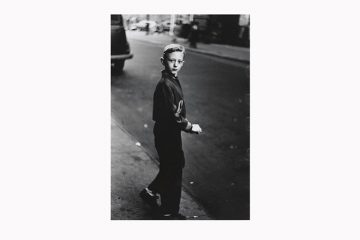Mark Prince at the TLS:
 In the era of Instagram and YouTube, when photography has mostly become a means of projecting oneself into the world to gauge its reaction, it takes an imaginative leap to recognize how revolutionary Diane Arbus’s murky photographs of some of the more disturbing corners of New York life must have looked back in the late 1950s, when they first appeared. Before her, photographers who wanted to be artists strove for impartiality, as if the camera were the eye of a stern god. Photographing passersby, they might tuck a camera into an overcoat to conceal from the subject (and viewer) the exchange being enacted between seeing and being seen. Arbus changed all this, taking pictures that record a direct encounter between photographer and stranger, and in so doing transformed a documentary medium, which had evolved out of the myth of its own objectivity, into a meeting of two pairs of eyes, with the lens standing in for one of the pairs. We never see her, but her presence, as an implicated observer, is everywhere apparent. These are pictures which never claim we can assume their images apply to any other viewpoint than her own.
In the era of Instagram and YouTube, when photography has mostly become a means of projecting oneself into the world to gauge its reaction, it takes an imaginative leap to recognize how revolutionary Diane Arbus’s murky photographs of some of the more disturbing corners of New York life must have looked back in the late 1950s, when they first appeared. Before her, photographers who wanted to be artists strove for impartiality, as if the camera were the eye of a stern god. Photographing passersby, they might tuck a camera into an overcoat to conceal from the subject (and viewer) the exchange being enacted between seeing and being seen. Arbus changed all this, taking pictures that record a direct encounter between photographer and stranger, and in so doing transformed a documentary medium, which had evolved out of the myth of its own objectivity, into a meeting of two pairs of eyes, with the lens standing in for one of the pairs. We never see her, but her presence, as an implicated observer, is everywhere apparent. These are pictures which never claim we can assume their images apply to any other viewpoint than her own.
more here.
